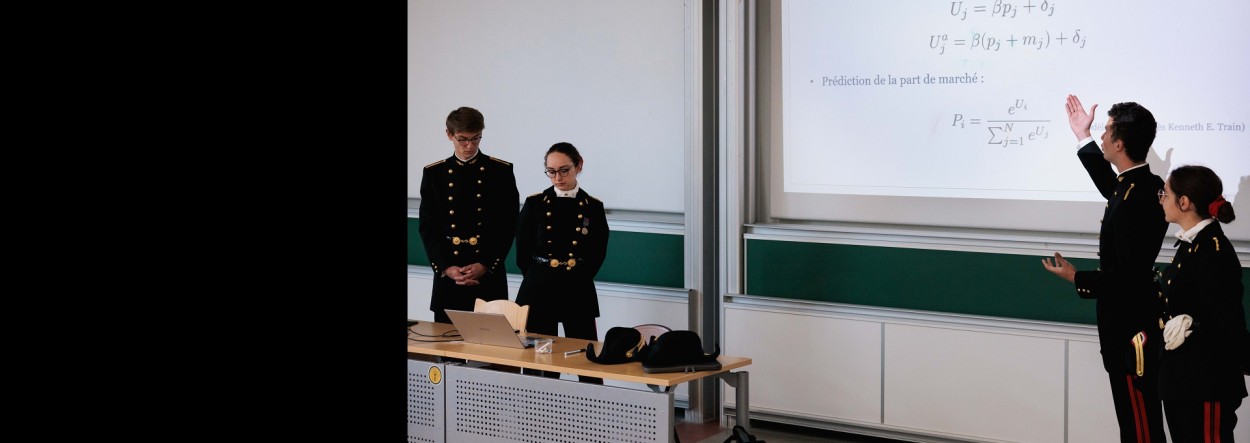Three collective scientific projects from the X2022 class awarded

Nine collective scientific projects (CSP), selected by the education and research departments from 112 groups in the X2022 class, were pitched to a jury of leading figures from academia, business and the press, at the finals held on September 16. Three projects were awarded.
All second-year Cycle Ingénieur Polytechnicien students take part in a CSP, the aim of which is to work collectively (in groups of 4 or 5 students) to identify and work towards solving a large-scale problem, or to design and produce an innovative technological demonstrator, by independently implementing one or more scientific disciplines over a long period, using an appropriate method and organization.
A CSP involves players from all over École Polytechnique (scientific departments, laboratories, technical services…), as well as close partners, notably École Polytechnique’s Foundation (FX).
The topics chosen by the students may be in conjunction with a School laboratory, a third-party research organization, a company or a public body. The project is supervised by two key players: the coordinator and the tutor. The coordinator validates the project, monitors the key stages of the CSP and grades the project. The tutor (who may or may not belong to the school) has technical expertise on the subject and advises the students (bibliography, suggested contacts, etc.).
Award-winning CSPs
Proving the bunkbeds conjecture
The bunkbeds conjecture is an intuitive but difficult-to-prove statement from percolation theory that deals with sets of connected vertices in a random graph. The bunkbeds conjecture, first formulated in 1985 by Dutch physicist Pieter Kasteleyn, asserts that - in a specific setting and in a specific sense - two vertices of a graph are more likely to remain connected after the random elimination of certain edges if the graph distance between the vertices is smaller.
This CSP on the bunkbeds conjecture brought together Aurélien Arnoux, Elias Chouik Arthur Compoint, Ines El-Bouzaidi Tiali Clara Spector with coordinators Teddy Pichard, El Mahdi El Mhamdi and Beniamin Bogosel and tutor Lucas Gerin.
The project had two main aspects: a theoretical aspect involving a review of research articles on particular cases of the conjecture in order to understand their proofs, and the development of new proofs for certain particular cases of graphs (“line” graph and “circular” graph, of any size); a numerical aspect involving the realization of a computer-assisted proof (python and julia languages) of the superposed beds conjecture for all graphs of size 5 or less, and for a third of graphs of size 6.
Creation of Arabidopsis Thaliana mutants with a transposon-free genome
Arabidopsis thaliana is a small annual flowering plant belonging to the Brassicaceae family. It has a rapid life cycle (six weeks from seed to seed), is hardy and can self-pollinate. Its relatively small genome of around 135 million base pairs (Mbp) has made it the first plant whose genome has been fully sequenced. Thanks to these characteristics, it has become a reference model organism for both biological and genetic research.
The aim of the CSP, which brought together Solène Léger, Joseph Thoral, Pauline Goué, Marie Walliser and Lucie Chicaud, was to eliminate the COPIA78 and COPIA93 transposon families from the genome of the reference plant Arabidopsis thaliana, in order to study their role by deletion and the consequences of their absence on the plant's potential to adapt to its environment.
The project was coordinated by Laura Fioni and Yves Méchulam, with Pierre Baduel as tutor.
Preparing for the International Physicists’ Tournament (IPT)
Guillaume Delamarre, Martin Drieux, Jean Jourdan, Paul-Alexis Mor, Robin Ostertag and Guilhem Stricker took part in a project to prepare for the International Physicists' Tournament (IPT), coordinated and tutored by X researcher Guilhem Gallot. After winning the French selection, the team went on to place second in the final of the 16th IPT organized from April 2 to 6 by the Swiss Federal Institute of Technology in Zurich, Switzerland.
Other projects in competition
- Authenticated Key Exchange by post-quantum cryptography
- Reassessment of the ecological bonus/malus
- Magnetohydrodynamic drag reduction
- Architected materials and energy dominance
- Study of the exit spray of Saint Gobain Isover's nozzles
- Monotone matrix functions and Loewner's theorem
 Support l'X
Support l'X